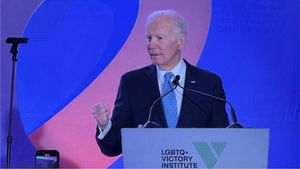Treatment GuideJust DiagnosedSex & DatingAfrican AmericanStigmaAsk the HIV DocPrEP En EspañolNewsVoicesPrint IssueVideoOut 100
CONTACTCAREER OPPORTUNITIESADVERTISE WITH USPRIVACY POLICYPRIVACY PREFERENCESTERMS OF USELEGAL NOTICE
© 2025 Pride Publishing Inc.
All Rights reserved
All Rights reserved
By continuing to use our site, you agree to our Privacy Policy and Terms of Use.
Peter Griffin marked 20 years of living with HIV infection this year. His long road has been anything but easy; he has had neuropathy in his feet, numerous hospitalizations, and eight life-threatening complications. But the 44-year-old New Yorker credits a surprising element with contributing to his ability to keep bouncing back to fight the disease'his 17 years of yoga classes. 'It helps me stay centered and lets me remember when I did feel well and get back to that,' Griffin says about practicing yoga. 'I think it's one of the big reasons I'm still here 20 years later.' Griffin is not alone. HIV-positive individuals frequently turn to yoga as a means of exercise and stress reduction. Many AIDS service groups, seeing increased demand for yoga and other alternative practices, either have launched classes themselves or regularly provide referrals to local yoga centers with programs for HIV-positive adults, says Ron Gonscak, wellness coordinator for AIDS Project Rhode Island. Yoga classes for people with HIV are now available in such cities as Atlanta, Chicago, Denver, Milwaukee, New York, Philadelphia, San Francisco, and Fort Lauderdale, Fla., among many others. 'People are looking for things they can do to help support their health and immune system beyond taking pills,' notes Gonscak, who helped launch free yoga and reiki classes at AIDS Project Rhode Island in January 2002. 'In the Northeast [United States] there's quite a bit of interest in acupuncture, reiki, and yoga.' Not Your Parents' Yoga The Sanskrit word yoga essentially means to join, usually thought of as the union of body and soul or of a person's soul with the universe as a whole. But for many with no real knowledge of the practice, yoga merely conjures up images of New Age fluff characterized by contorted body positions and repeated 'om' chanting. 'A lot of people have misconceptions about yoga and think that it's all about making your body into a pretzel and meditating,' Gonscak says, laughing. 'But there are lots of different types of yoga.' Most forms of yoga have their roots in two key practices: asana, a series of physical postures, and pranayama, breathing and energy-boosting techniques that are as much mental as physical. Visualization, relaxation, and meditation are other common components. Yoga techniques can range from being very vigorous'almost akin to calisthenics'to mostly relaxation and controlled breathing techniques, says David Nelson, a yoga instructor and the owner of San Francisco's Castro Yoga. Among the most common forms of yoga practiced in the United States are hatha yoga, which is based on a series of physical poses and breathing exercises, and vini yoga, which is breath-centered and tailored to the specific needs of each participant. Other popular yoga methods are raja, mantra, tantric, and kundalini. It Just 'Feels Good' The benefits of yoga are both physical and mental, says Karen Lee, a registered yoga instructor who teaches a class for clients at AIDS Project Rhode Island. 'It's an overall effect on the state of mind, the state of energy, the state of the body,' she says. In fact, the International Association of Yoga Therapists touts numerous benefits of yoga: improved nervous system function, respiratory and cardiac efficiency, cholesterol and triglyceride levels, musculoskeletal strength and function, sleep quality, and cognitive functions; pain reduction; and decreased anxiety and depression symptoms. A general sense of well-being achieved through yoga also can prod participants into other healthful practices, says Thomas Claire, author of the new book Yoga for Men: Postures for Healthy, Stress-Free Living. 'Yoga can have a domino effect'helping HIV-positive people to make other positive lifestyle changes,' he says. Although there have been no scientific studies to prove that yoga directly improves the immune system, practitioners and teachers alike believe it conveys significant immunological benefits. (A study has shown that yoga students who received flu shots had higher levels of flu-fighting antibodies than those who did not practice yoga, Lee points out.) 'It stimulates specific portions of the endocrine system, the thyroid and the parathyroid; strengthens respiratory and circulatory function; improves digestion; and calms the nervous system,' Nelson adds. 'Each of those are components to immunity in the body.' Why It Feels Good On a more basic level, yoga relieves stress, a major contributor to illness, Lee says. She notes that even HIV-negative people under a great deal of stress are prone to colds, flu, and other infections. Yoga helps to prevent those types of ailments by eliminating stress. 'Your heart rate drops, your blood pressure drops, stress hormones start to dissipate,' she says. 'That's what I think people are finding with yoga in terms of boosting their immune systems.' There are psychological benefits from yoga as well'outside of the soothing effects of the practice, Nelson explains. Classes designed specifically for HIV-positive adults become something of a support network and provide opportunities for the participants to discuss other HIV-related issues and problems. Others find that regular yoga classes provide welcome opportunities to socialize in a safe and nonjudgmental environment. 'The stigma of HIV is still very evident,' Gonscak notes. 'A lot of HIV-positive people are quite isolated. So any time people can get together and interact with other people who are positive and build a network of support is important.' Find the Form That Fits You If you do decide to explore adding yoga to your wellness plan, a good first step is to check out any class and its instructors before signing up, paying particular attention to the amount and type of training the teachers have received, Nelson recommends. 'You should use the same level of scrutiny that you would in finding a therapist or a doctor or any professional you'd entrust your health to,' he says. And because yoga can vary greatly depending on the type being taught and even among instructors within a certain yoga style, both Nelson and Lee recommend that anyone interested in the practice try out different classes, styles of yoga, and teachers before settling on a particular approach. 'What it really boils down to is that there's a yoga for everyone at this point,' Lee says. 'If you try one and find it's not for you, try a different one. You'll be able to find one that works for you.'
From our Sponsors
Most Popular
“So much life to live”: Eric Nieves on thriving with HIV
September 03 2025 11:37 AM
The Talk: Beyond the exam room
August 13 2025 3:15 PM
Thanks to U=U, HIV-positive people can live long, happy, healthy lives
July 25 2025 2:37 PM
BREAKING: Supreme Court rules to save free access to preventive care, including PrEP
June 27 2025 10:32 AM
Messenger RNA could be the key to an HIV vaccine — but government cuts pose a threat
August 20 2025 8:02 AM
“I felt like a butterfly”: Niko Flowers on reclaiming life with HIV
July 23 2025 12:22 PM
Dancer. Healer. Survivor. DéShaun Armbrister is all of the above
July 02 2025 8:23 PM
The Talk: Starting the conversation
July 25 2025 4:47 PM
The lab coat just got queer
August 21 2025 10:00 AM
Plus: Featured Video
Latest Stories
HIV-positive men stage 'Kiss-In' protest at U.S.-Mexico border
December 01 2025 12:56 PM
What the AIDS crisis stole from Black gay men
December 01 2025 6:00 AM
Amazing People of 2025: Javier Muñoz
October 17 2025 7:35 PM
It’s National PrEP Day! Learn the latest about HIV prevention
October 10 2025 9:00 AM
“I am the steward of my ship”: John Gibson rewrites his HIV narrative
September 16 2025 2:56 PM
The Talk: Owning your voice
August 25 2025 8:16 PM
The Talk: Navigating your treatment
August 01 2025 6:02 PM
How the Black AIDS Institute continues to fill in the gaps
July 25 2025 1:06 PM
1985: the year the AIDS crisis finally broke through the silence
June 26 2025 11:24 AM
VIDEO: A man living with HIV discusses his journey to fatherhood
June 10 2025 4:58 PM
Trump admin guts $258 million in funding for HIV vaccine research
June 03 2025 3:47 PM
Grindr is reminding us why jockstraps are so sexy and iconic
May 02 2025 5:36 PM
HRC holds 'die-in' to protest Trump health care cuts
April 28 2025 2:11 PM
Two right-wing Supreme Court justices signal they may uphold access to PrEP and more
April 21 2025 4:10 PM
500,000 Children at Risk: PEPFAR Funding Crisis
April 08 2025 3:51 PM
Broadway's best raise over $1 million for LGBTQ+ and HIV causes
April 03 2025 7:15 PM
The Talk Season 5 premieres this spring with HIV guidance for the newly diagnosed
March 26 2025 1:00 PM








































































